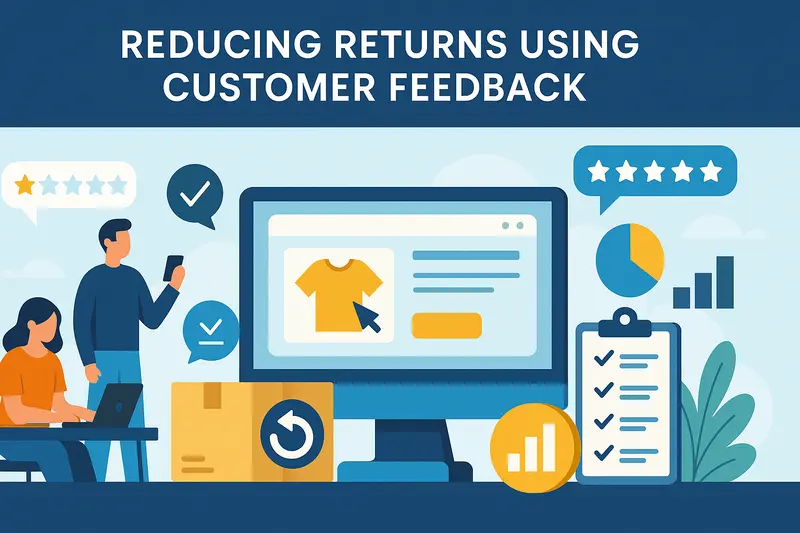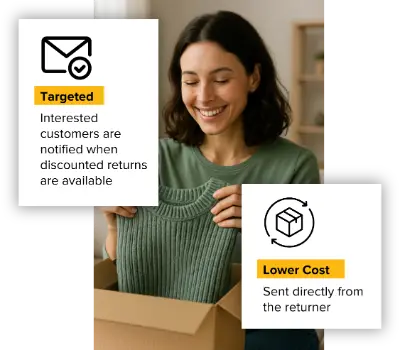How to Reduce Returns in Ecommerce by Using Customer Feedback

Last updated on October 03, 2025

Ecommerce returns are a headache. No ecommerce business likes them, but unfortunately, they’re a necessary part of the industry. Customers expect them, and keeping customers happy is job #1 if you have any chance of them buying from you more than once. But let’s not kid ourselves: returns eat into your profit margins, and when you’re working with thin margins, every return feels like a punch to the gut.
But here’s the good news: customer feedback can actually help you reduce those returns. That’s right…you can stop returns before they even happen. How? By listening to your customers and giving them what they really want. Because at the end of the day, fewer returns = happier customers = more profit. And who doesn’t love a little extra profit?
Make Returns Profitable, Yes!
Cut shipping and processing costs by 70% with our patented peer-to-peer returns solution. 4x faster than traditional returns.
See How It WorksWhy Collecting Customer Feedback is Crucial for Reducing Returns
Here’s the thing: returns happen for a reason. It could be because the item didn’t fit right, the color was different from what was seen online, or maybe it just didn’t live up to expectations. The problem is, if you don’t ask why customers are sending things back, you’re just guessing. You’re left wondering if it’s the product, the size guide, or maybe the moon was in retrograde the day they ordered. Whatever it is, if you don’t collect feedback, you’re left in the dark, making assumptions about what’s causing those returns.
But when you collect feedback, you stop playing the guessing game. You get to the root causes of those returns, and more importantly, you get to fix them. Is the sizing off? Update your size guide. Are your product descriptions too vague? Time to make them clearer. Does the item look different from the picture in real life? Well, that’s a big one, and you’ll want to fix it fast.
Collecting customer feedback not only helps you figure out why returns are happening, but it also shows customers that you’re listening. Nobody likes to feel like they’re shouting into the void. When you actively make changes based on what your customers are saying, they feel heard, and that builds trust. Happy customers = fewer returns. It’s really that simple.
What Feedback to Collect
So, you’re sold on the idea of collecting feedback. But what should you be asking your customers? Where do you even start? Here’s a short list of things you really want to know:
- Product Fit and Quality: This is the big one, especially for apparel and footwear. You know the story: customers buy something, it shows up, and it doesn’t fit right. Maybe it’s too tight, too loose, or just doesn’t have the feel they were hoping for. Feedback helps you refine your product descriptions and improve sizing guides, which in turn minimizes how many times customers send items back because they “just didn’t fit the way I thought they would.”
- Product Descriptions: Let’s face it, we’ve all been there. You see a product online, get excited, order it, and when it arrives, it’s nothing like what you expected. That’s when the dreaded return process begins. If feedback shows your product descriptions are misleading or missing key details, it’s time to tighten them up. Accurate product descriptions aren’t just important, they’re essential to reducing returns. If customers know exactly what they’re getting, they’re less likely to be disappointed.
- Customer Expectations: This one’s a bit tricky. Sometimes, it’s not about the product itself, it’s that customers thought they were getting something different. Maybe they were expecting a higher-quality material, or the color in real life isn’t as vibrant as it looked online. Collect feedback on these kinds of expectation mismatches so you can adjust the way you present products to make sure customers get what they expect.
- Customer Behavior Post-Purchase: After a customer places an order, do they feel confident in their purchase? Did they get the right info? If you’re seeing returns due to “buyer’s remorse,” or a customer changing their mind, it might be a sign you need to improve your return policy or offer store credit options upfront. People like to have options, especially when they’re not sure about their purchase. So, ask them how they feel post-purchase and adjust accordingly.
- Customer Service Experience: Is your customer service team dropping the ball during the returns process and making things worse? Did your team handle the return smoothly? Or did they leave the customer feeling frustrated? Feedback on the customer service experience can help you fine-tune the process so customers don’t get stuck in a never-ending loop of “I’m sorry” and “Can you please hold?” which leads to a negative brand interaction that may push the customer away forever.
Convert Returns Into New Sales and Profits
Our peer-to-peer returns system instantly resells returned items—no warehouse processing, and get paid before you refund.
I'm Interested in Peer-to-Peer ReturnsHow to Collect Customer Feedback
Now that we know what we need to ask, how do we actually get that feedback? Here are a few methods that can make the process smooth and painless:
- Post-Purchase Surveys: The easiest way to get feedback is with a simple, post-purchase survey. Keep it short and sweet; just ask a few key questions about their experience with the ecommerce site, if the product matched the description, and if the sizing guide was helpful. Keep it brief to increase response rates. It’s an easy way to get valuable info without overwhelming the customer.
- Returns Portal Feedback: Your returns portal is an ideal place to collect feedback. After a customer initiates a return, give them an option to explain why they’re returning the item. Make it easy to select from options like “Size issue,” “Product didn’t match description,” or “Changed my mind.” You can even ask them to elaborate a little more if needed. This will give you specific insights into the return reasons and pinpoint exactly what needs fixing.
- Customer Service Interactions: Whenever a customer calls or chats with your support team about a return, have them ask a couple of follow-up questions. It’s a casual way to collect feedback while solving the problem. Don’t let this opportunity go to waste; use it to get actionable insights to improve your operations.
- Product Reviews and Ratings: Reviews aren’t just for your products; they’re for your ecommerce experience too. Customers will often mention issues with fit, quality, or service in their reviews. Pay close attention to negative feedback, this is where the real opportunities for improvement lie.
Implementing Feedback to Reduce Returns
Collecting feedback is one thing, but acting on it is what really makes a difference. Here’s how to take the feedback you gather and turn it into action:
- Update Product Descriptions and Images: If you’re getting feedback about confusing descriptions, fix them. Be specific about materials, sizing, colors, and any other important details. When customers know exactly what they’re buying, there’s no room for disappointment.
- Improve Sizing Guides: This one’s huge, especially for fashion ecommerce stores. If customers are consistently returning items because they didn’t fit right, it’s time to take a hard look at your sizing guides. Add more detailed measurements and offer better recommendations for customers based on their past purchases or reviews.
- Clear Return Policy: If customers are frustrated with your return process, make it easier. Improve communication. Be upfront about your return policy from the start. And, if possible, offer free return shipping. Customers will appreciate the transparency and convenience, and it will make them less likely to return items in the first place.
- Encourage Exchanges: Instead of offering cash refunds every time, try encouraging customers to exchange the item. This keeps the sale intact and satisfies the customer at the same time. Plus, it keeps future purchases in-house, rather than giving up on the sale and going to a competitor.
Measuring the Results
Once you’ve made changes based on the feedback received, it’s time to measure the impact. Are your return rates going down? Are customers leaving better reviews? Are you getting more repeat business? Keep a close eye on the data and keep refining your approach to continuously improve both your ecommerce returns process and the overall customer experience.
Summary: Customer Feedback Is Your Secret Weapon
The bottom line: If you want to reduce returns and improve your ecommerce store’s performance, customer feedback is how you identify the problems and craft suitable solutions. But remember, it’s not just about fixing problems, it’s an opportunity to prevent them. So listen to your customers, act on their feedback, and watch your return rates drop while customer satisfaction and loyalty increase. Build that relationship, and when you do, you’ll also enjoy a healthier bottom line.

Turn Returns Into New Revenue


 7 minutes
7 minutes